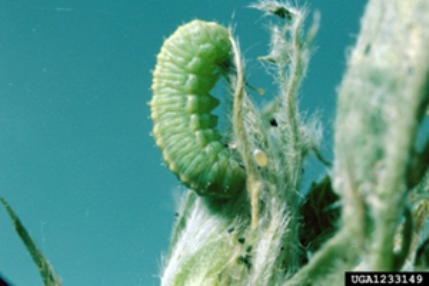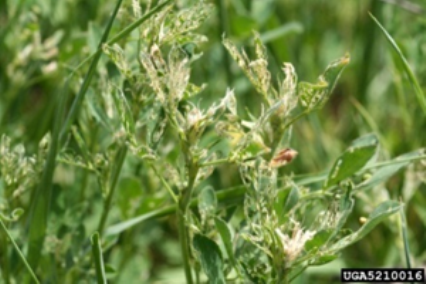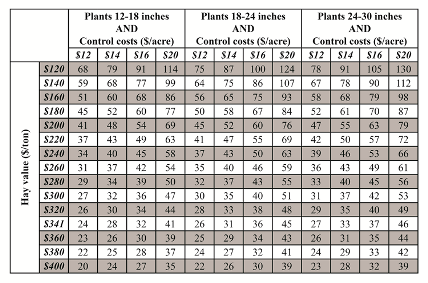Start Scouting for Alfalfa Weevil with Updated Economic Thresholds
By
Posted April 11, 2014
By
Posted April 11, 2014
Even though it was an extremely cold winter, some alfalfa weevil adults are expected to survive. Adults will begin moving as soon as temperatures exceed 48°F and begin laying eggs in alfalfa. Alfalfa weevil eggs develop based on temperature, or accumulating degree days, and hatching can start around 200-300 degree days. Start scouting alfalfa fields south of Interstate 80 at 200 degree days and fields north of Interstate 80 at 250 degree days. Based on accumulated temperatures since January, weevils are active in southern Iowa now and scouting to monitor for larval activity should start in southwestern Iowa this weekend (Fig. 1).

Figure 1. Accumulated growing degree days (base 48°F) in Iowa from January 1 - April 10, 2014. Map courtesy of Iowa Environmental Mesonet, ISU Department of Agronomy.
This dynamic degree day map is updated daily. To more accurately time scouting efforts in April and May, use this website to generate up-to-date information for your area. Click on the “View Degree Day Map” button in the left corner of the page and then set the parameters for degree days to create a new map. Make sure to set the start date to January 1 of the current year and the end date to today; set base temperature to 48°F and ceiling temperature to 86°F.
Alfalfa weevil is an important defoliating pest in alfalfa. Heavy infestations can reduce tonnage and forage quality. Adults feed on plants, but typically the larvae cause the majority of plant injury. Female alfalfa weevils can lay 800-4,000 eggs in a lifetime and insert 5-20 at a time into alfalfa stems. Newly hatched larvae can be found feeding on terminal leaves, leaving newly expanded leaves skeletonized. Gradually maturing larvae (Photo 1) move down the plant and begin feeding between leaf veins. Peak larval activity occurs around 575 degree days. Often silken pupal cases are attached to leaves in the lower canopy or in leaf litter. The time it takes to reach the adult stage is dependent on temperature, but can take about eight weeks. Adults (Photo 2) eat along the leaf margin, leaving irregular notches. A heavily infested field will look frosted or silver (Photo 3).

Photo 1. Alfalfa weevil larvae have a dark head and pale green body with a white stripe down the back. Fully-grown larvae are about 5/16 inches long. Photo by Clemson Cooperative Extension Slide Series, www.ipmimages.org.

Photo 2. Alfalfa weevil adults have an elongated snout and elbowed antennae. Their wings and body are mottled or brown in color. Photo by Clemson University, ipmimages.org.

Photo 3. Heavily-defoliated alfalfa fields appear frosted from a distance. Photo by Whitney Cranshaw, Colorado State University, ipmimages.org.
After reaching benchmark degree days (200 in southern Iowa and 250 in northern Iowa), use a sweep net to sample for adults and larvae. South-facing slopes warm up faster and may be a place to start sampling. After larvae are first collected in sweep nets, collect six alfalfa stems from five locations throughout the field. Take each stem and vigorously shake into a bucket to dislodge larvae from the plant. Small larvae can be difficult to separate from the plant and therefore careful plant inspection is also needed. Average the number of larvae per 30 stems and plant height to determine if the economic threshold is approaching (Table 1). Remember, cutting alfalfa is an effective management tool for alfalfa weevil larvae, and an insecticide application may be avoided if harvesting within a few days of reaching the economic threshold. For more information on how to interpret the table, click here.

Table 1. Economic threshold of alfalfa weevil, based on the average number of larvae in a 30-stem sample (Originally published by John Tooker, Penn State Extension).
AgraScout is a mobile crop scouting application designed for retailers that enables seamless, simultaneous communication between scouts, agronomists, and growers. Neucadia, the team of agronomists, systems analysts, and crop scouts behind AgraScout understood both the importance of scouting and the difficulty in passing on timely information found in the field. Neucadia built AgraScout because they wanted an easier, quicker way to communicate field information. AgraScout was designed to close the gap between what the scout sees and what the grower knows so whatever your role, you can make intelligent decisions about your business.
Copyright © 2014 neucadia, llc